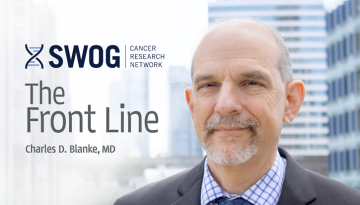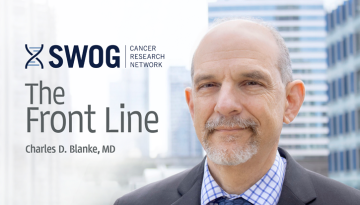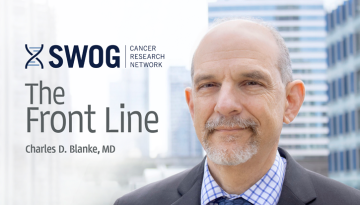A Truly Impressive Bank Balance
SWOG and the NCI National Clinical Trials Network (NCTN) have huge biobanks of specimens that serve as amazing resources for translational medicine (TM) research. The SWOG biobank, housed at Nationwide Children’s Hospital in Columbus, Ohio, holds more than 1.3 million specimens contributed with informed consent by more than 70,000 trial participants, collected over decades from hundreds of clinical trials – some FDA registration studies – covering a wide range of cancers.
What makes these biospecimens particularly valuable is that they’re linked to high-quality, well annotated, clinical trial outcomes and other data, including patient-reported outcomes, many from prospective, randomized NCTN trials.
Molecular profiles and biomarkers derived from these specimens can be linked to this trove of clinical data via our incredible team of SWOG statisticians, meaning the biobank is an ideal resource for identifying and validating prognostic and predictive biomarkers.
These specimens and their associated clinical data might also be used, for example, to confirm drug efficacy or to assess new methods to monitor treatment effectiveness.
Banked biospecimens are available for TM studies, via review and approval by SWOG leadership or by the NCTN Core Correlative Sciences Committee (CCSC), in secondary TM projects once a clinical trial has been published. This includes older studies and negative studies, but also more recent trials that have completed and published their preplanned TM studies.
How can investigators (SWOG members or not) get access to these resources?
NCTN Navigator is a streamlined route to more than 2.5 million NCTN biobank specimens. These include a subset of SWOG’s biobank resources mentioned above: 200,000 (soon to grow to 300,000+) biospecimens from 16,000+ patients enrolled to 20 SWOG trials. Navigator’s inventory includes specimens from NCTN phase 2/3 and phase 3 trials – and large biospecimen collection protocols with clinical data – that:
- were activated in 1995 or later and
- are completed, with the primary outcome reported.
The NCTN Navigator interface allows you to search for biospecimens and to gather information and publications related to the trials in which those specimens were collected. From within the portal, you can generate a letter of intent (LOI) to establish biospecimen availability and use in accordance with human research protections, and can then submit a TM proposal for using the specimens and associated clinical data.
Most approved NCTN Navigator TM proposals test a specific hypothesis or validate a biomarker rather than being exploratory, although hypothesis-generating and exploratory studies can get approval for use of biospecimens collected from negative clinical trials.
Even though NCTN Navigator includes only 20 SWOG trials right now, if you’re interested in specimens from multiple trials and any one of those trials is in NCTN Navigator, you’ll need to submit your entire request through the portal, so it’s the best place to start.
The NCTN has invested considerable effort, both before and since NCTN Navigator’s rollout in 2018, to make the process of identifying and requesting biospecimens and data straightforward and efficient. They continue work to identify – and remove – pain points.
The user guide delves into details of the process, but this quick visual overview on the login page may be a better first stop.
The NCTN Navigator interface lets you search available specimens via a dozen vectors – by trial, diagnosis, agent, path status, anatomical source, keyword, … you get the picture. Results are sorted by trial, with a link to the clinicaltrials.gov page for each, complete with lists of trial publications. Once you’ve identified the specimens you need, you can pull your results directly into your draft letter of intent (LOI), which you complete and submit on the site.
If your LOI request is deemed feasible, you can submit a full proposal via NCTN Navigator that will be reviewed by the NCTN CCSC.
If that proposal is approved (which may come after requested revisions), you’ll need to document your funding, IRB approval, and data and material use agreements before specimens and data can be distributed from the biobank.
How long is the review process? In an earlier Front Line, I discussed publication of the results of a TM project that analyzed banked serum specimens from the S0226 breast cancer trial. The NCTN Navigator request that led to those results took about a year from initial submission of a letter-of-intent (to learn whether the desired samples were available), through submission of the full proposal, through the CCSC’s request for – and the study team’s resubmission of – a revised proposal, to final CCSC approval.
Once your proposal is approved, the delivery time to get your biospecimens from the bank will vary based on the number requested and whether additional processing is required (such as nucleic acid extraction). But our biobank colleagues at Nationwide Children’s Hospital are happy to estimate that timeline based on your proposal outline (reach out to Nationwide’s Erin Grundy for help).
Shipping costs to deliver specimens to your lab and data retrieval and processing costs will vary, but again, biobank staff will work with you to provide a quick ballpark estimate once they know the rough parameters of what you need.
What if the specimens you want aren’t available in NCTN Navigator? Talk to the chair, TM chair, and biostatistician for the appropriate SWOG research committee(s) to learn whether the materials you’re looking for might be among the additional 1.1 million biospecimens from smaller and older SWOG trials that aren’t yet available in NCTN Navigator. These leaders get regular updates on the specimen inventory and can offer critical advice on your project.
To request these non-Navigator SWOG biospecimens, visit the Biospecimen Resources page [now the Biospecimen Access page] on the SWOG website. From there, you can complete and submit a SWOG Biospecimen Query Form to confirm whether the samples you want are available. Once you have confirmation, you can submit a Proposal for a Translational Medicine Study using a SWOG standardized TM proposal form that is only three to five pages long.
To encourage our researchers to take advantage of this amazing trove of resources, and to guide them in the process for accessing and using said resources, SWOG Vice Chair for TM Lee Ellis, MD, is planning a translational medicine plenary for our spring meeting in Seattle that will feature guidance on using NCTN Navigator for your TM project. Keep an eye open for details on this Plenary I session.
Our investigators frequently publish results of TM work they’ve carried out using specimens requested from SWOG’s biobank. In fact, roughly one in six SWOG publications (abstracts included) reports results of secondary research on biospecimens from our trials.
With the number of specimens in the SWOG biobank growing rapidly, I expect that one-in-six fraction will also grow steadily over the coming years. Some changes to access might be coming, but this is the best way to proceed at present!
Other Recent Stories



